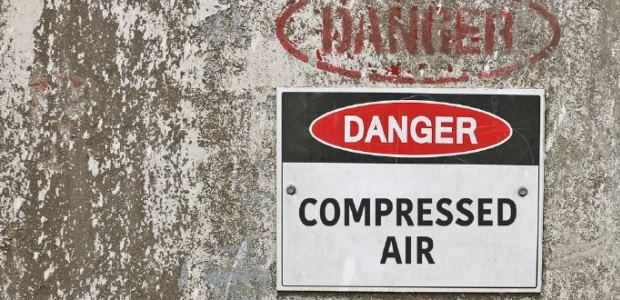
Pressure Increases to Implement Safe Alternatives to Compressed Air
Growing awareness of the dangers and potential liabilities of compressed air has industries and institutions exploring new options.
- By Michael Hurley
- Sep 01, 2017
Compressed air is so commonly used in commercial, industrial, and institutional settings that it is often incorrectly assumed to be less potentially dangerous than it actually is. In fact, there are numerous hazards associated with compressed air, and accidents and injuries involving compressed air cost U.S. business millions of dollars each year. These costs are both direct and indirect, involving medical emergencies, equipment damage, production wastage, production downtime, as well as rising insurance costs and increased regulatory burdens.
Compressed air poses three distinct inherent risks: from air pressure, airborne particulate matter, and noise. These risks are increased when compressed air technology is used in an unsafe or negligent manner and also when the equipment is not maintained in optimal condition. Thousands of accidents occur each year because employees are improperly trained or unaware of the dangers of compressed air, and thousands more are the result of improperly installed or maintained systems or components.
Beyond these immediate risks, compressed air systems have proven to be costly to install, operate, and maintain in full compliance with safety regulations. The existence of high-pressure compressed air for pneumatic operations may increase insurance liabilities.
Evolving workplace safety regulations and increased awareness of the risks and costs associated with traditional compressed air have created a rapidly expanding market for a new generation of low-pressure systems for use where compressed air would pose an unacceptable level of risk. These systems are typically designed to limit exposure to pressurized air streams and airborne particulates and operate at noise levels well within regulatory guidelines. An unexpected benefit of these alternative systems is that they are also generally less expensive to operate.
High Pressure Equals High Risk
The optimal operating pressure for compressed air systems in industrial and manufacturing applications is typically between 80 and 120 psi, although some systems specify even higher pressures. These pressures can cause severe injuries if the compressed air is directed at personnel, even accidentally and for a short time. As such, compressed air systems are never suitable for blowing dust or debris off of clothes or bare skin. Cleaning of machinery with compressed air creates blowback that may contain wood or metal chips and other production-related debris.
The potential for even more serious injury exists wherever compressed air may enter the body through an orifice or an open cut or wound. In addition to the possibility of particulate matter entering the bloodstream, even relatively clean compressed air can cause serious and potentially fatal injuries.
Federal regulations require that nozzles for compressed air hoses include a pressure relief feature, however, even this specification still exceeds safe levels. To safely blow debris off personnel, the installation of a separate OSHA-compliant system is essential. OSHA requires that such systems include a chip guard to protect operators from hazardous blowback.
A Matter of Airborne Particulates
 Compressed air systems do not deliver clean air. The airflow produced by these systems, which include a compressor or compressors, hoses, clamps, fittings, and nozzles, contains trace amounts of oil, water, dust, and other microscopic particulates, many of which cannot be eliminated even with the use of filtering equipment. In many instances, systems also recycle additional particulate matter generated by the processes occurring within the facility.
Compressed air systems do not deliver clean air. The airflow produced by these systems, which include a compressor or compressors, hoses, clamps, fittings, and nozzles, contains trace amounts of oil, water, dust, and other microscopic particulates, many of which cannot be eliminated even with the use of filtering equipment. In many instances, systems also recycle additional particulate matter generated by the processes occurring within the facility.
These particulates pose dangers for both plant personnel and equipment. If compressed air is used to clean off machinery, dirt and debris may be inadvertently blown into the equipment, affecting performance. The dangers are even more pronounced when compressed air is directed, for whatever reason, at personnel. The pressure of compressed air can force microscopic debris and particulates into the eyes, nose, mouth, and open cuts, resulting in infections and permanent injuries.
Fears About Ears
Air compressors and compressed air systems are known to be significant contributors to high levels of workplace noise, which is recognized as a hazard and regulated by OSHA. Even small compressors generate potentially harmful levels of noise and require that operators and other exposed personnel use ear protection. Industrial multi-unit compressor banks for plant-wide pneumatics operate at dangerously high decibel levels at all times.
High levels of noise are a particular concern for schools, colleges, art museums, and other institutions that may be using compressed air in shop environments. With no real need for the high-pressure discharge from traditional compressors, the potential liabilities of compressed air systems may greatly outweigh any benefits.
Decompress for Safety
The real hazards and the alarming scope of potential liabilities associated with compressed air systems have only recently become fully apparent through a combination of scientific research, technological developments, and the accumulation of medical data from a growing database of case studies. This awareness has in turn spurred extensive new regulatory guidance, enforcement, and intervention.
This uncertain environment has created a demand for market alternatives such as low-pressure, low-noise systems that deliver clean air and adhere to or exceed OSHA and CE standards. These systems may be particularly attractive to educational and institutional markets where personal safety is paramount. But even large-scale industrial operations committed to pneumatics can improve safety, ensure regulatory compliance, limit liabilities, and realize savings by deploying these safer alternatives for personnel and equipment cleanup.
Compressed Air Hazards
The dangers associated with the use of compressed air systems in commercial, industrial, educational, and institutional facilities are well-documented by medical researchers and regulatory authorities such as OSHA and the Council of Europe.
- Air discharge pressures are unsafe for contact with the skin
- Air discharge contains multiple contaminants
- Blowback from air discharge may contain production debris
- Air compressors contribute to hazardous noise levels
Growing awareness of these hazards has led to increasing regulatory oversight worldwide. The use of compressed air for cleaning plant equipment or personnel is prohibited in parts of Canada and Europe.
Hidden Costs of Compressed Air
Compressed air systems are common in industrial facilities, but the true costs and potential liabilities associated with these systems are typically underestimated by management.
- Energy-intensive and expensive to operate
- Accidents, injuries, insurance liabilities
- Safety training, enforcement, regulatory compliance
- Equipment damage, product wastage, air leakage, production downtime
Compressed air is costlier than utilities such as water, electricity, and natural gas. Greater regulatory oversight and rising energy prices will increase these costs over time.
This article originally appeared in the September 2017 issue of Occupational Health & Safety.